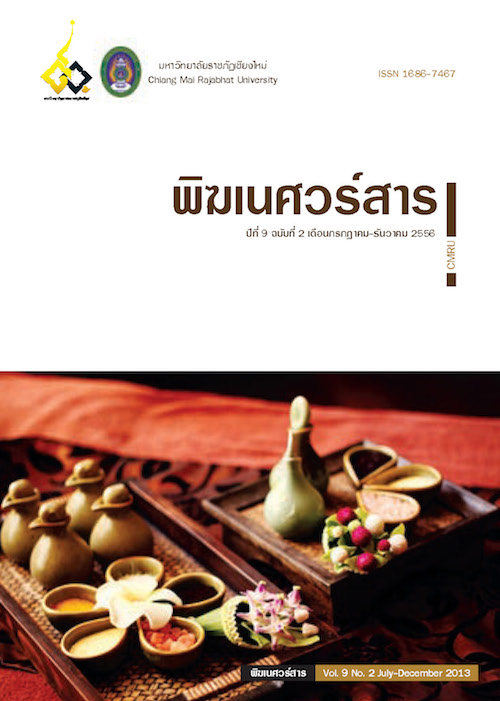ปัจจัยที่มีความสัมพันธ์ต่อการป้องกันและควบคุมโรคไข้เลือดออกของประชาชน ในเขตตำบลท่าเดื่อ อำเภอดอยเต่า จังหวัดเชียงใหม่
Main Article Content
Abstract
การวิจัยเชิงพรรณนานี้มีวัตถุประสงค์เพื่อศึกษาถึงความสัมพันธ์ระหว่างคุณลักษณะทางประชากรและปัจจัยต่างๆ ได้แก่ ปัจจัยนำ ปัจจัยเอื้อ และปัจจัยเสริมที่มีผลต่อการป้องกันและควบคุมโรคไข้เลือดออกของประชาชนในเขตตำบลท่าเดื่อ อำเภอดอยเต่า จังหวัดเชียงใหม่ โดยประยุกต์แนวคิดทฤษฎีการวิเคราะห์พฤติกรรมสุขภาพ PRECEDE Model ของ Green & Kreuter ประกอบด้วยปัจจัยนำได้แก่ ความรู้, ความคิดเห็น และการรับรู้ต่อการป้องกันและควบคุมโรคไข้เลือดออก ปัจจัยเอื้อ ได้แก่ ความพอเพียงของทรัพยากรและการมีทักษะในการใช้ทรัพยากรในการป้องกันและควบคุมโรคไข้เลือดออก และปัจจัยเสริม ได้แก่ การได้รับคำแนะนำหรือกระตุ้นเตือนจากเจ้าหน้าที่สาธารณสุขหรืออาสาสมัครสาธารณสุขหรือบุคคลที่ใกล้ชิด สำหรับกลุ่มตัวอย่างได้จากการคัดเลือกผู้ที่เป็นหัวหน้าครัวเรือนหรือตัวแทน จำนวน 302 ครัวเรือนในแต่ละหมู่บ้านในตำบลท่าเดื่อ อำเภอดอยเต่า จังหวัดเชียงใหม่ เลือกโดยการสุ่มอย่างมีระบบ เก็บข้อมูลโดยใช้แบบสัมภาษณ์ วิเคราะห์ข้อมูลโดยใช้สถิติพรรณนา สัมประสิทธิ์สหสัมพันธ์เพียร์สันและไคสแควร์
การศึกษาแสดงให้เห็นว่า อายุ การศึกษา สถานภาพ อาชีพ รายได้ มีความสัมพันธ์กับการป้องกันและควบคุมโรคไข้เลือดออกที่มีประสิทธิภาพอย่างมีนัยสำคัญทางสถิติที่ระดับ.01 เพศไม่มีความสัมพันธ์กับการป้องกันและควบคุมโรคไข้เลือดออกที่มีประสิทธิภาพอย่างมีนัยสำคัญทางสถิติที่ระดับ.01 ผลการศึกษาด้านปัจจัยนำได้แก่ความรู้ (P=0.000), ความคิดเห็น (P=0.000), การรับรู้ (P=0.002) ปัจจัยเอื้อได้แก่ ความพอเพียงของทรัพยากรและสิ่งอำนวยความสะดวกจาก
หน่วยบริการของภาครัฐในการป้องกันและควบคุมโรคไข้เลือดออก (P=0.000) และปัจจัยเสริม ได้แก่ การได้รับคำแนะนำจากเจ้าหน้าที่สาธารณสุข, อสม.หรือบุคคลใกล้ชิดในครอบครัวและการได้รับแรงจูงใจโดยการได้รับรางวัลจากส่วนราชการได้รับคำชมจากเจ้าหน้าที่ (P=0.007) มีความสัมพันธ์ทางบวกกับการป้องกันและควบคุมโรคไข้เลือดออกที่มีประสิทธิภาพอย่างมีนัยสำคัญทางสถิติที่ระดับ .01 และพบว่าในส่วนของปัจจัยเอื้อได้แก่ การมีทักษะในการใช้ทรัพยากรป้องกันและควบคุมโรคไข้เลือดออก (P=0.416) ไม่มีความสัมพันธ์กับการป้องกันและควบคุมโรคไข้เลือดออกที่มีประสิทธิภาพอย่างมีนัยสำคัญทางสถิติที่ระดับ.01
รูปแบบการดำเนินงานป้องกันและควบคุมโรคไข้เลือดออก ให้มุ่งเน้นสนับสนุนปัจจัยที่มีผลต่อพฤติกรรมการป้องกันและควบคุมโรค ได้แก่ ความรู้ ความคิดเห็น การรับรู้เกี่ยวกับการป้องกันและควบคุมโรคที่ถูกต้องและการสนับสนุนทรัพยากรในการป้องกันและควบคุมโรคไข้เลือดออกให้พอเพียง รวมถึงการส่งเสริมการมีทักษะในการใช้ทรัพยากรป้องกันและควบคุมโรคไข้เลือดออกที่ถูกต้องให้แก่ประชาชนซึ่งจะส่งผลให้ประชาชนมีพฤติกรรมการป้องกันและควบคุมโรคไข้เลือดออกถูกต้องเหมาะสมยิ่งขึ้นส่งผลให้อัตราการป่วยด้วยโรคไข้เลือดออกลดลง
FACTORS RELATED TO PREVENTION AND CONTROL OF DENGUE HEMORRHAGIC FEVER AMONG PEOPLE IN THADUA SUB-DISTRICT, DOITAO DISTRICT, CHIANG MAI PROVINCE
The objective of Descriptive Research was focus on the relationship between demographic characteristics and various other factors. These factors were leading factors, contributing factors and factors affecting to prevention and control of Dengue Hemorrhagic Fever (DHF) in Tha Dua Sub-District, Doitao District, Chiangmai Province by application of concepts and theories of health behavior analysis PRECEDE model of Green & Kreuter. Each of the leading factors were include knowledges, opinions and awareness to prevent and control of DHF. The contributing factors were include the sufficient of resources and skills used for the prevention and control of DHF. The various other factors were include the instructions or stimulations from public health staffs, health volunteers or relatives. The samples were selected from household heads or agents of 302 housholds in each village in Tha Dua Sub-District, Doitao District, Chiangmai Province. A systemic random data were collected by interview. Data were analyzed by descriptive statistics correlation coefficient of Pearson and chi-square.
The study found that age, education, marital status, occupation and income were associated with the prevention and control of DHF effectively with the statistically significant at.01 Gender was not related to the prevention and control of DHF effectively with the statistically significant at .01. The study shown that the leading factors were knowledge (P=0.000), comments (P=0.000) and awareness (P=0.002). The contributing factors were sufficient of resources and facilities from government units of prevention and control of DHF (P=0.000) and various other factors were recommendations of public health staffs, health volunteers or relatives and motivated by awards from government staffs (P=0.007) which were found positively related to the prevention and control of DHF effectively with statistically significant at.01 and the contributing factors were skills in use of resources to prevent and control of DHF (P=0.416) which no relation to the prevention and control of DHF effectively statistically significant at.01.
The efficiency of prevention and control of DHF, should focus on factors affected the prevention and control of disease. Such factors include knowledges, comments, awareness on the prevention and control of disease and sufficient support of resources to prevention and control of DHF. Including the promotion of skills in use of resources to prevent and control in public which would result in the prevention and control of DHF and lower the incidence rate.
Downloads
Article Details
The articles published are copyrighted by the Graduate School, Chiang Mai Rajabhat University.
The opinions expressed in each article of this academic journal are solely those of the individual authors and do not reflect the views of Chiang Mai Rajabhat University or its faculty members. The responsibility for the content of each article rests entirely with the respective authors. In the event of any errors, the authors alone are responsible for their own articles.


